INTRODUCTION
Today, it’s normal to care about our carbon footprint and recycle, but it wasn’t always that way. It was during the 1960s, a time when people were ready for all kinds of change and were excited about working together to fix problems, that people started worrying about the environment.
Young people who loved nature began to care about the environment. They found support in the White House and Congress as part of Johnson’s Great Society, and saving the Earth became a national conversation.
By understanding how the environmental movement began and how it changed over time, we can learn about our own ecological future. This is important because, as you know, concern about the future of the environment is an even more important topic now than it was in the 1960s. What do you think? Can we save the Earth?
A HISTORY OF CONSERVATION
The modern environmental movement that most people are familiar with started in the 1960s, but its roots go back much further in time.
During a period called the Progressive Era, which was around the turn of the 20th century, people started to care more about protecting America’s wilderness. Famous conservationist John Muir worked with politicians to create national parks, forests, and wildlife refuges. They believed it was important to preserve nature for its beauty.
President Theodore Roosevelt was a friend of Muir and he also supported conservation. He made sure that large areas of land were protected for national parks and nature preserves. However, there were different views on how best to use America’s wildlands. Some people, like John Muir, believed that nature should be preserved for its own sake, as it was beautiful and unique. Others, like Roosevelt, believed that nature was a resource to be used for things like electricity and lumber. That same debate continues even today.
During the Great Depression, President Franklin Roosevelt started programs to protect natural resources and to help fight the effects of the Dust Bowl. One of the most popular programs from Roosevelt’s New Deal was the Civilian Conservation Corps, which gave young men jobs working to build parks and trails.
After World War II, the growing suburbs and highways led to more development in wilderness areas, which worried conservationists. They successfully blocked projects like the proposed Bridge Canyon Dam that would have provided electricity to growing cities but would also have flooded part of the Grand Canyon.
In the 1950s and 1960s, pollution from factories in big cities got so bad that it became a serious problem no one could ignore. One famous example was the Cuyahoga River in Cleveland, Ohio, which caught fire multiple times due to oil pollution.
However, it was not a river on fire that ignited the modern environmental movement. It was a book.
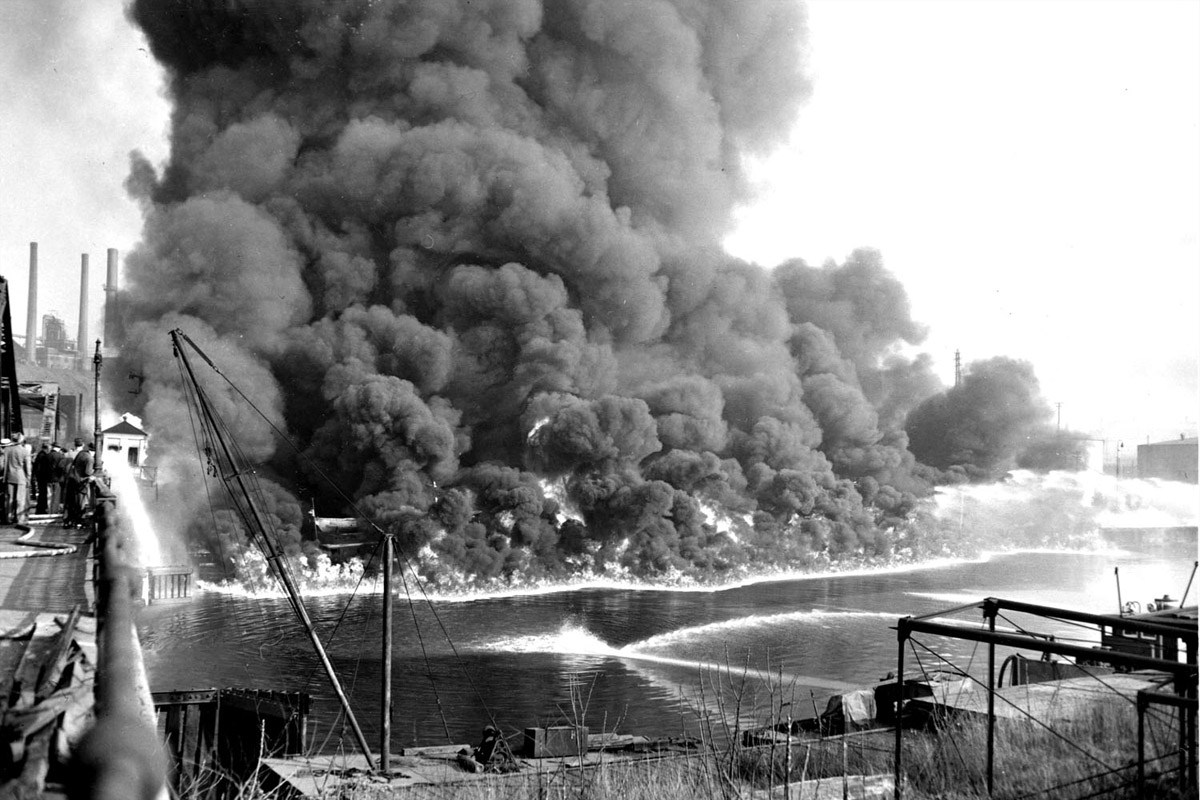 Primary Source: Photograph
Primary Source: Photograph
The Cuyahoga River on fire in Cleveland, Ohio. Images of the burning river published in Time Magazine helped Americans understand the extent of industrial pollution and the importance of regulations such as the Clean Water Act.
RACHEL CARSON AND SILENT SPRING
In 1962, Rachel Carson wrote a book called Silent Spring. The book talked about a pesticide called DDT that was used on many American farms. People liked DDT because it killed insects and helped farmers grow more, but Carson showed that the DDT was getting washed off the farms by the rain and slowly worked its way through the food chain. In the end, she explained, the pesticide was hurting the birds in America. When birds ate food with DDT in it, their eggshells became too thin to protect their babies. This meant that fewer birds were being born each year, which led to a domino effect though the environment. Carson wrote about a spring when there were no birds to sing, and no frogs or crickets either. It was a silent spring.
Silent Spring was an important book because many young people involved in civil rights, anti-war, and the counterculture movements became interested in environmental issues after reading it. Silent Spring changed the way people thought about pollution.
An immediate impact of Silent Spring was the campaign to ban DDT. In 1967, a group called the Environmental Defense Fund was formed to help with this campaign. They went to court and argued that, along with rights like freedom of speech, people had the right to a clean environment. The campaign to ban DDT was successful, in part, because Bald Eagles were also dying. The Bald Eagle is the national bird, and many people did not want to see it go extinct. By 1972, DDT was phased out in the United States except in emergency cases.
Another issue that Carson wrote about was a problem with the government. The Department of Agriculture was responsible for regulating pesticides, but also is supposed to help farms to be successful. This created a conflict of interest. Often, Carson wrote, the government was helping the farmers first and not doing enough to protect the environment. In 1970, the Nixon Administration created the Environmental Protection Agency (EPA) to address this problem. The EPA’s only job is to protect the environment and make sure that people follow the rules to keep it clean.
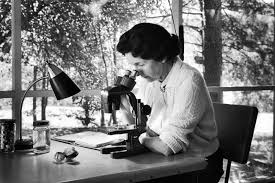 Primary Source: Photograph
Primary Source: Photograph
Rachel Caron’s book Silent Spring is seen as the catalyst for the modern environmental movement.
PRESIDENT JOHNSON
Rachel Carson got things started with Silent Spring, but President Lyndon Johnson also played an important role in the beginnings of the environmental movement. In fact, some people think he was the best president for the environment that America has ever had. President Johnson’s wife, Lady Bird Johnson, was also very interested in protecting the environment. She worked hard to support her husband’s environmental programs and traveled the country promoting environmental projects.
President Johnson gave speeches about how important it was to take care of the air, water, soil, and wildlife. He said that society had to be responsible for controlling the poisons and chemicals that were hurting the environment. He believed that conservation was not just about protecting nature, but also about restoring what had been destroyed and making cities more beautiful. During Johnson’s presidency, Congress passed many important laws to help protect the environment, including the Clean Air Act and the Clean Water Act. These laws limited pollution from factories and power plants, protected wilderness areas, and helped endangered species. As part of his Great Society, many other laws passed as well to make the environment cleaner and healthier for people and wildlife.
A GROWING MOVEMENT
Protecting the Earth became a global issue. On March 21, 1970, the world celebrated the first Earth Day to raise awareness about environmental issues. A year later, the United Nations Secretary-General spoke about the importance of protecting our planet, calling it a “spaceship Earth.” The United Nations held its first major conference on international environmental issues, the Stockholm Conference, in 1972. This led to the formation of the Convention on International Trade in Endangered Species (CITES) in 1975. Luckily, this was also the time of detenté during the Cold War when countries on both sides of the Iron Curtain were looking for ways to work together. Protecting the environment was something everyone could agree on.
At home, young Americans were learning about conservation in school and a nationwide awareness campaign was started to get people to limit pollution. The Forest Service created a character named Woodsy Owl to encourage kids to “Give a Hoot, Don’t Pollute.” Many people were moved by television ads that showed piles of trash and a Native American shedding a single tear.
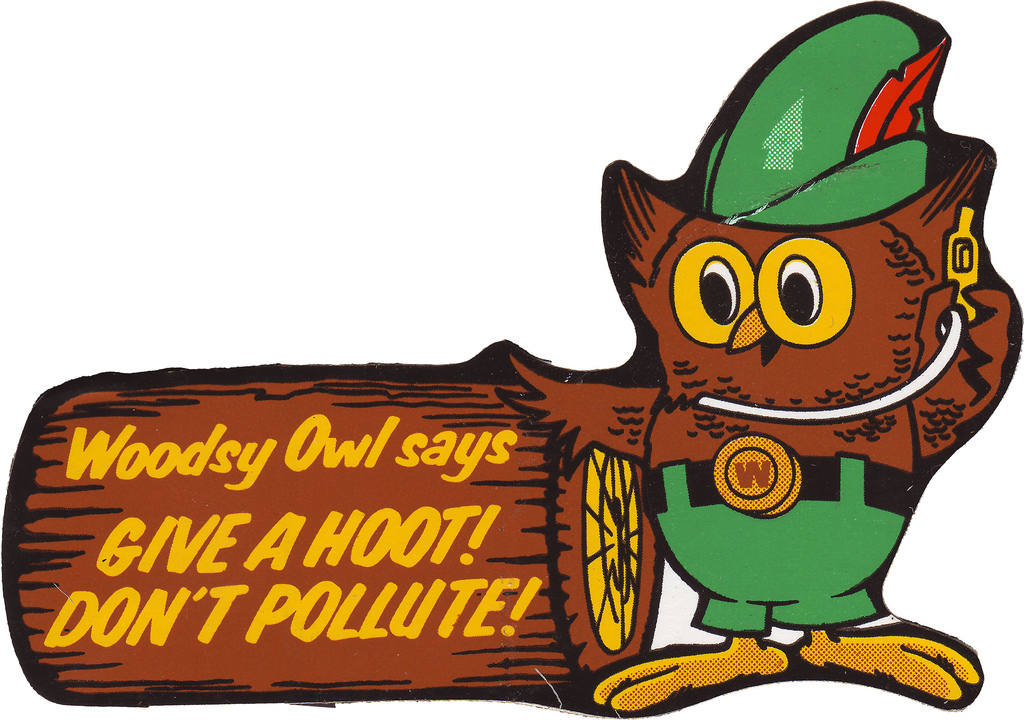 Primary Source: Illustration
Primary Source: Illustration
Woodsy Owl provided young Americans in the 1970s with a gentle reminder not to pollute. Programs like this brought environmental conscientiousness into the mainstream.
THE CHAMPIONS OF CONSERVATION
The government has been working to protect the environment since the 1960s by passing laws and paying for scientific research. However, it’s non-profit organizations that do a lot of the work. These are groups that collect donations to pay for their work.
Greenpeace is an organization that works on issues such as global warming, deforestation, and overfishing. They use direct action, lobbying, and research to reach their goals. Although they are the most visible environmental organization in the world, they have also been controversial because sometimes Greenpeace volunteers try to stop Japanese whale hunts.
The World Wildlife Fund (WWF) is the largest environmental organization in the world. They support many projects and raise money to pay governments in developing countries to protect their natural resources. For example, the WWF might pay off the debts the government of a small African country owes if they create a new national park.
Other major environmental groups include the Nature Conservancy, which raises money to buy land to protect it from development, John Muir’s Sierra Club, and the National Wildlife Fund.
CLIMATE CHANGE
In the beginning, the environmental movement focused on issues like burning rivers, pesticides, and protecting endangered species. However, in recent years, the focus has shifted to greenhouse gas emissions, which could have long-term and devastating effects on our planet. Humans have been releasing large amounts of greenhouse gases, especially carbon, into the atmosphere since the beginning of the industrial revolution in the 1800s. This has caused the overall temperature of the Earth to slowly go up. While this increase may seem small, just a degree or two could have huge consequences in the coming years. The melting of ice near the poles could lead sea levels to rise, putting low-lying islands and cities at risk, including major ports like New York and New Orleans. Some island countries in the Pacific and Indian Oceans may even disappear.
It isn’t just people living near the oceans that will feel the effects of climate change. As temperatures rise, the weather will change as well. This will affect people, plants, and animals everywhere and could disrupt water and food supplies, even in places far from the ocean.
To address this problem, world leaders met in Rio de Janeiro in 1992 and signed the United Nations Framework Convention on Climate Change (UNFCCC), which set the rules for future treaties. The first major treaty about limiting greenhouse gas emissions was the Kyoto Protocol, which set goals for cutting back on greenhouse gas emissions that developed countries had to work toward. While all major industrial nations have ratified the Kyoto Protocol, the United States and Canada have not yet signed on.
A follow-up treaty to set emissions goals beginning in 2020 was signed in Paris, France. It is called the Paris Agreement. However, both the Kyoto Protocol and Paris Agreement face criticism. Some argue that the treaties do not go far enough to limit greenhouse gases, while others believe that meeting goals will hurt people’s jobs more than it will help the environment.
The biggest criticism of these agreements is that they only set goals for rich countries, while not setting such goals for poorer, but fast-growing countries. Many critics in the United States see this as unfair since the United States would have to change the way we live and work to reduce emissions and meet the goals of the agreements. These changes are often expensive. However, countries like China and India do not. However, growing economies point out that the United States and Europe polluted for over 100 years as they became rich, and it seems unfair that just when they are becoming world powers, they would be asked to pay for the same expensive changes to protect the environment.
Overall, participation in international environmental treaties has become a political issue in the United States. While people disagree about whether or not the Kyoto and Paris Agreements will really work to fight climate change and if they are fair, it is clear that something needs to be done.
CLIMATE CHANGE DENIAL
In 2006, some scientists were beginning to be concerned that politicians were interfering in scientific research about climate change. In a survey that year, almost three out of four scientists who were getting money from the government to pay for their research said that they thought their work was being changed or edited to make it seem like climate change wasn’t real. Some politicians used these changed reports to say that scientists didn’t agree about climate change. However, that’s not true. Most scientists around the world agree that climate change is real, caused by humans, and will have a big impact on our lives in the future.
People who don’t believe in climate change are often supported by big businesses that don’t want to follow rules about how much pollution they can make. These companies may lose millions of dollars if new environmental laws are passed that limit carbon emissions or encourage people to use alternative forms of energy, like solar power. These companies have a lot of money and can pay for people to make fake studies that try to prove climate change isn’t real. Unfortunately, in the United States, Republican politicians have often agreed to take campaign donations from these organizations and have promoted this idea of climate skepticism.
To work against this, environmentalists like former vice president Al Gore have tried to teach people about climate change. In 2006, Al Gore released a movie called An Inconvenient Truth. Even though some of what he said wasn’t quite right, most of what he said was based on what scientists know about climate change. In 2007, Al Gore and a group of scientists won the Nobel Peace Prize for their work to teach people about climate change.
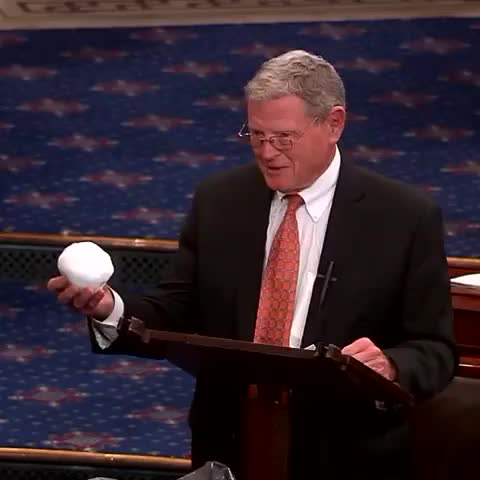 Primary Source: Photograph
Primary Source: Photograph
Senator Jim Inhofe holds a snowball during his climate change denial statements in the Senate chamber in 2015.
TRUMP’S WAR ON THE ENVIRONMENTAL MOVEMENT
During President Trump’s time in office, he tried to put the needs of businesses over protecting the environment. Overall, he believed that the government should protect people’s jobs. He argued that too much had been done to protect the environment and these laws and regulations hurt businesses and jobs.
As soon as President Trump was inaugurated, the White House took down any mention of climate change on their website, except for when they said they would get rid of rules made by past presidents to deal with climate change. Even the Environmental Protection Agency removed climate change information from their website while Trump was president.
Trump and the people who worked for him in the government did not enforce the laws about pollution as strictly as the presidents who came before him. They brought fewer cases against companies that were polluting, gave out lower penalties, and made fewer requests to make facilities cleaner.
President Trump got rid of the Stream Protection Rule, which was made to stop coal mining debris from being dumped into streams nearby. They also got rid of regulations that limited power plants from dumping toxic wastewater into rivers, which could contain harmful metals like arsenic and mercury. In 2017, President Trump reversed rules made by President Obama to limit climate change. He said he was doing this to help the coal industry and remove “job-killing regulations.”
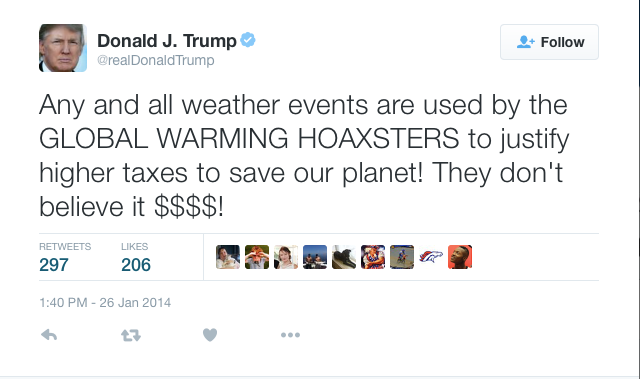 Primary Source: Tweet
Primary Source: Tweet
Although innovative in his use of Twitter to communicate directly with the nation, President Trump has demonstrated a willingness to promote climate skepticism (among other conspiracy theories) and has actively supported business interests over environmental stewardship.
The EPA under President Trump refused to ban the toxic pesticide chlorpyrifos, even though EPA staff had recommended that it be banned due to the negative effects it has on children’s health. However, a court later ordered the EPA to ban the pesticide, because the EPA’s leaders had ignored the advice of their own scientists.
In 2017, President Trump announced that the United States would not be part of the Paris Agreement.
President Trump’s administration also suspended many government-funded research programs. These included a study on how mountaintop removal coal-mining affects public health, a program to make offshore drilling safer, and funding for a program that gave out grants to study the effects of chemical exposure on children.
President Trump cut the size of two national monuments in Utah, unlike previous presidents who usually follow Teddy Roosevelt’s lead and protect land from development.
Despite President Trump’s efforts to ignore climate change, he could not make it go away.
In 2021, when President Biden took office, he began reversing many of the changes that President Trump had made. He announced that the United States would rejoin the Paris Agreement and that addressing climate change would be one of his top priorities. Even businesses began to see climate change as a problem that needed to be addressed. For example, General Motors announced that by 2035 all the cars and light trucks they made would run on electricity instead of gasoline.
CONCLUSION
When we look at President Trump’s four years in power, we might see an unusual shift away from protecting the environment in an otherwise long line of leaders who have cared about conservation. Others might see it as a troubling sign that companies who are against environmental protections are gaining too much power. Unlike companies, nature can’t pay for bad research, which makes it important for regular people to do our part to protect our planet.
We know that humans have negatively affected our planet. But we also know that government regulations have made a difference in the past, like with the Bald Eagle’s protection. But now we face a bigger challenge with climate change. As young Americans, it’s up to us to find a way to solve this problem or adapt to a warmer world. What do you think?
Can we save the earth?
CONTINUE READING

SUMMARY
BIG IDEA: The environmental movement as we know it today started in the 1960s. Over time the focus has shifted from preserving natural wonders to preventing pollution to mitigating the effects of climate change. In recent decades, significant opposition to the environmental movement has emerged.
Americans have been concerned with preserving the environment since the Progressive Era when President Theodore Roosevelt launched the National Park Service and John Muir founded the Sierra Club.
During the Great Depression FDR implemented the CCC and dealt with the Dust Bowl and during the 1950s people worked to stop construction of a dam that would have partially filled in the Grand Canyon.
The modern environmental movement started when Rachel Carson wrote Silent Spring and helped Americans become aware of the dangers of the pesticide DDT. Her work led to the creation of the Environmental Protection Agency.
President Johnson and his wife Lady Bird Johnson both cared about the environment and the Clean Air and Clean Water Acts were part of Johnson’s Great Society.
During the 1960s and 1970s the environmental movement grew. Earth Day was started and new non-governmental organizations were founded to fight for conservation.
In modern times, climate change is the most pressing concern. International agreements such as the Kyoto Protocol and Paris Agreement have implemented goals for carbon emission reduction. Different presidents have chosen to join or withdraw from these agreements.
Some people reject the overwhelming science that supports human-induced climate change. These climate skeptics were originally funded by business groups who will lose money if carbon emissions are reduced. Republican politicians, including President Trump, promote the ideas of climate skeptics and work to block environmental regulation. Most Democrats, like former Vice President Al Gore, advocate for regulations to limit climate change.

VOCABULARY
![]()
PEOPLE AND GROUPS
Rachel Carson: Scientist who wrote Silent Spring about the dangers of pesticides and launched the modern environmental movement.
Lady Bird Johnson: First lady and white of President Lyndon Johnson. She promoted education and environmental legislation. She is famous for declaring “where flowers bloom, so does hope.”
Woodsy Owl: Cartoon character created in the 1970s to encourage children not to litter.
Greenpeace: Environmental organization that is famous for direct action campaigns such as interfering with whaling ships.
World Wildlife Fund (WWF): Largest non-profit environmental protection organization in the world.
Al Gore: Former Vice President who has dedicated himself to fighting to protect the environment. He wrote An Inconvenient Truth.
![]()
SCIENCE
DDT: Pesticide that can case fatal problems in animals, especially birds, after it has been washed into rivers and lakes. It was the subject of Rachel Carson’s book Silent Spring and was banned shortly after the book’s publication.
Greenhouse Gas: Chemical that prevents solar energy from leaving the atmosphere and consequently leads to a gradual warming of the overall temperature of the planet. Carbon dioxide is the most famous.
Global Warming: The slow processes of increasing the Earth’s average temperature. It is due to human activity and could lead to major changes in weather, sea level, and other natural processes.
Climate Skepticism: The belief that global warming is not happening or that it will not result in significant changes. It is an idea first promoted by businesses that will suffer if limits are place on greenhouse gas emissions.
![]()
BOOKS
Silent Spring: Book written by Rachel Carson about the dangers of pesticides. The book helped launch the modern environmental movement.
An Inconvenient Truth: Book by former Vice President Al Gore about climate change.
![]()
GOVERNMENT AGENCIES
Environmental Protection Agency (EPA): Government agency responsible for enforcing laws designed to protect the environment.
![]()
EVENTS
Cuyahoga River Fires: Fires that took place when oil and other flammable pollutants in the major river in Cleveland ignited. They occurred multiple times, the largest in 1952. In 1969, it was featured on the cover of Time Magazine and helped focus national attention on the problem of pollution.
Earth Day: March 21. First observed in 1971, it is a day to focus on the environment.
![]()
LAWS & TREATIES
Clean Air Act: Law passed in the 1960s that regulates air pollution.
Clean Water Act: Law passed in the 1960s that regulates water population.
Kyoto Protocol: International agreement signed in 1997 that established as framework for future greenhouse gas emissions reduction treaties.
Paris Agreement: Follow-up treaty to the Kyoto Protocol that sets greenhouse gas emissions targets beginning in 2020.
